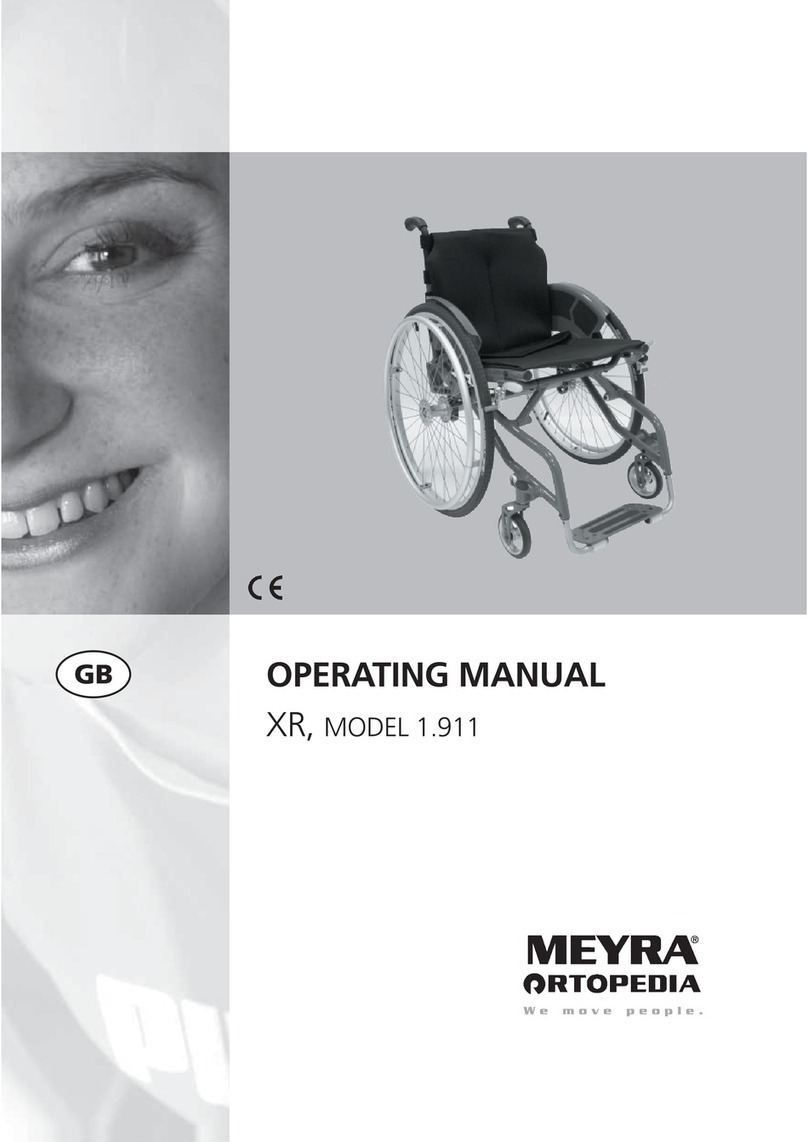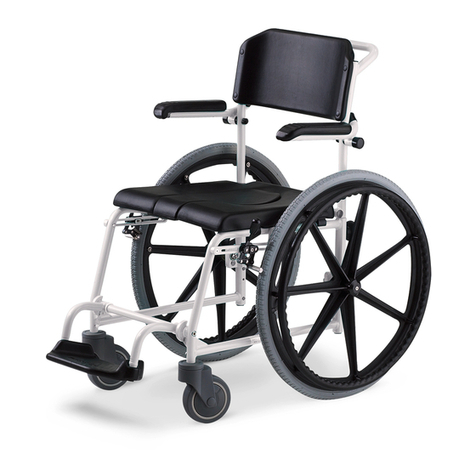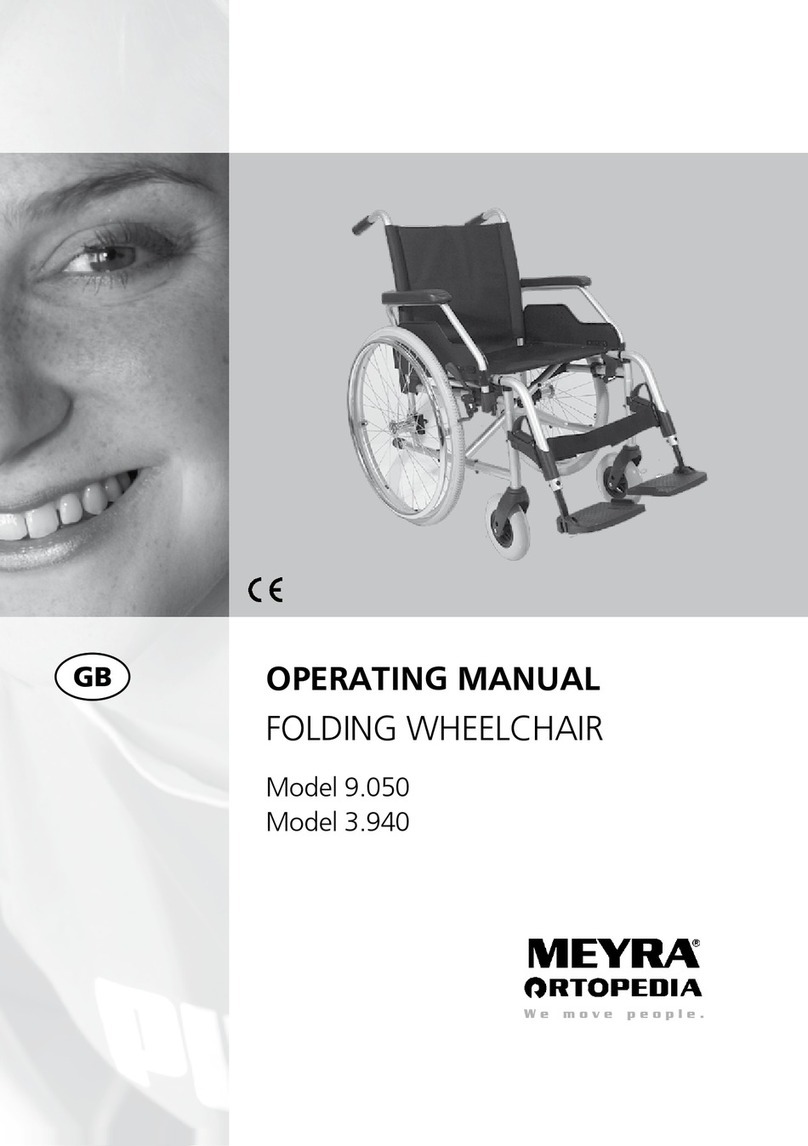Meyra-Ortopedia 1.360 User manual

GB
We move people.
OPERATING MANUAL
FOLDING WHEELCHAIR
Model 1.360

2

3
Contents
Introduction .................................................................................................. 5
Important information ........................................................................................6
List of models ............................................................................................... 6
Indications .....................................................................................................7
Acceptance .................................................................................................... 7
Specifications ................................................................................................8
Use ................................................................................................................. 8
Adjustment ...................................................................................................9
Reinstallment ................................................................................................9
Life span ........................................................................................................ 9
Overview .....................................................................................................10
Model 1.360 ...................................................................................................10
Brake ............................................................................................................ 11
Locking the pressure brakes ..............................................................................11
Releasing the pressure brakes ...........................................................................12
Calf belt ....................................................................................................... 13
Adjusting the calf belt .......................................................................................13
Removing/attaching the calf belt .....................................................................13
Leg supports ............................................................................................... 14
Continuous leg support .....................................................................................14
Swivelling up the footboard ........................................................................14
Swivelling down the footboard ...................................................................14
Clothes guard.............................................................................................. 15
Back support ............................................................................................... 16
Back support belt ...............................................................................................16
Fitting the back belt .....................................................................................16
Push handles .......................................................................................................17
Height adjustable push handles ..................................................................17
Height adjustment of the push handles .....................................................17
Removing the push handles .........................................................................18
Inserting the push handles ...........................................................................18

4
Seat ..............................................................................................................19
Seat belt ..............................................................................................................19
Utensils bag ...................................................................................................19
Wheels ......................................................................................................... 20
Tyre damage on pneumatic tyres ......................................................................20
Drive wheels........................................................................................................20
Quick release axle .........................................................................................20
Quick release axle with tetra locking device Code 697 .............................21
Support castors........................................................................................... 22
Swinging the support castors .......................................................................22
Retaining strap ........................................................................................... 23
Fastening the retaining strap ............................................................................23
Opening the retaining strap..............................................................................23
Adjustment of belt length .................................................................................23
Folding/Unfolding ....................................................................................... 24
Folding the wheelchair ......................................................................................24
Carrying the wheelchair ....................................................................................24
Unfolding the wheelchair ..................................................................................24
Transport .....................................................................................................25
Transport security ...............................................................................................25
Transport of people inside a motor vehicle .....................................................25
Maintenance ............................................................................................... 26
Maintenance .......................................................................................................26
Information for the specialist dealer ...........................................................26
Maintenance schedule ..................................................................................27
Technical data .............................................................................................30
Model 1.360 ........................................................................................................31
Meaning of the labels on the wheelchair ........................................................34
Meaning of the symbols on the type plate ......................................................35
Inspection certificate ................................................................................. 36
Notes ............................................................................................................ 37
Warranty / Guarantee .................................................................................38
Inspection certificate for transfer .....................................................................39

5
INTRODUCTION
We thank you for the confidence you
have placed in our company by choos-
ing a wheelchair from this series.
The model of your selection, fulfils
the wish for mobility and more inde-
pendence by way of a new styling of
the proven MEYRA-Ortopedia tech-
nology.
With all equipment and their accesso-
ries the wheelchair offers die respec-
tive adaptation to your disability.
Additional information about our
products can be found on our website
under:
< www.meyra-ortopedia.com >.
☞ Contact your specialist dealer
when required.
Like any other vehicle, a wheelchair is
a technical aid. It is subject to expla-
nations, requires regular care and can
cause danger when used improperly.
The correct handling must therefore
be learned. This operating manual
is to help you get accustomed to the
handling of the wheelchair as well as
to prevent accidents.
☞ Note:
Please note that the illustrated
equipment variants can deviate
from your model.
We have therefore also listed chapters
with options that might not be appli-
cable for your individual wheelchair.
Other manuals for 1.360
1
Table of contents
Other Meyra-Ortopedia Wheelchair manuals

Meyra-Ortopedia
Meyra-Ortopedia XR 1.911 User manual

Meyra-Ortopedia
Meyra-Ortopedia McWET 8013039 User manual

Meyra-Ortopedia
Meyra-Ortopedia McWET 8013039 User manual

Meyra-Ortopedia
Meyra-Ortopedia 9.050 User manual

Meyra-Ortopedia
Meyra-Ortopedia VR2 User manual

Meyra-Ortopedia
Meyra-Ortopedia 1.360 User manual

















